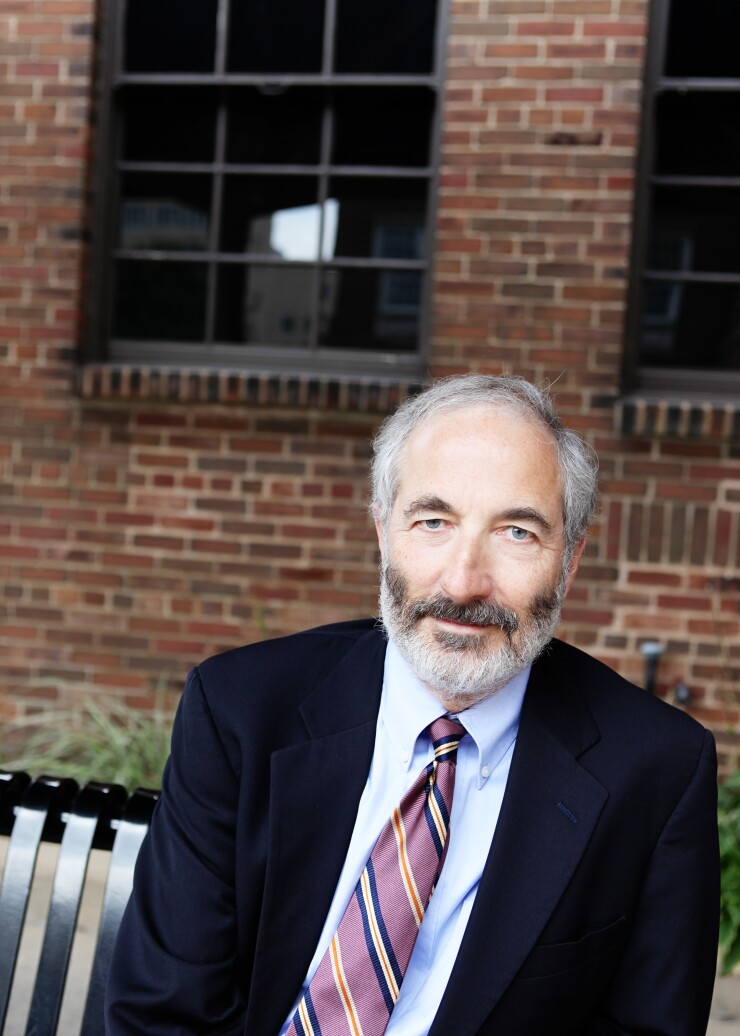Want unlimited access to top ideas and insights?
Bill Hampel may have retired from the Credit Union National Association, but he’s quick to point out that with 39 years under his belt he is by no means leaving the credit union industry.
“A lot of people have known for several months that I’m going to retire, and a few folks have reached out to me for consulting stuff,” he told Credit Union Journal. “In the next quarter I already have four or five things already set up, so it’s not like I’m falling off the end of a cliff. It’s slowing down instead of going cold turkey. I have a work trip scheduled for the weekend after next already.”
First on the agenda, however, is relocating. Having spent the first two decades of his credit union career based in Madison, Wis. and the following two decades in Washington, Hampel is set to move to Tampa with his wife to be closer to one of the couple’s children.

Being active at such a high level of a national trade association helped Hampel make a name for himself, but he also contributed to that by being a mainstay at credit union conferences and educational events.
While his final title at CUNA was chief policy officer, it might not be a stretch to refer to him as the movement’s chief educator. In addition to economics-focused lectures at credit union conferences, he has long been a teacher for CUNA Management schools. He holds a doctorate in economics and spent a few years teaching at the college level – first as a graduate teaching assistant, later as a lecturer – before coming to CUNA. But he said he never regretted leaving academia.
“I go around speaking all the time, which I view as educational,” he said. “I do that the same way I’d teach a class. When you speak to a credit union audience it’s like speaking to an undergraduate class, with the difference being that the people listening to you are interested in what you have to say and intent on finding out what they might find useful in their jobs, as opposed to people who would just as soon not be there and are really only worried about what’s going to be on the test.”
A bigger, better movement
It would be an understatement to say the industry has changed during Hampel’s time at CUNA. When he started at the trade association, there were only 40 million credit union members nationally in 1978, compared to more than 110 million today. Similarly, the movement only had $60 billion in assets then (about $225 billion in today’s dollars, when adjusted for inflation, he said), and today total assets stand at more than $1.4 trillion.
“The credit union movement is in much better, much more dynamic shape than it was 40 years ago,” he said. “The only shortcoming is back then we had 22,000 credit unions and now we have a little under 6,000, but those 6,000 credit unions serve almost three times as many people with over six times the assets, even after adjusting for inflation.”
And while he admits CUs were “bit players in a niche market” when he came to the industry, “they’ve blossomed since then and become full-service retail financial institutions operating under the cooperative model. I didn’t have much to do with that – I just watched it and helped credit unions along the way, which means I was really lucky to work in those times and see how things developed.”
For all the movement’s success during his career, however, there are a number of things Hampel says could still be done better. For starters, he said, credit unions could stand to be slightly less risk-averse – though he quickly concedes that risk aversion is “endemic to our cooperative structure.”
“One of my themes with credit unions is to explain that there are a lot of benefits to being risk-averse in a depository institution that operates on trust and is responsible for managing these assets on behalf of member-owners,” he said. But, he added, if management is aware of their natural tendency toward avoiding risk, they may be able to self-correct slightly and take on a bit more manageable risk that could benefit the institution. And that starts, he said, with capital -- a mantra Hampel has espoused for much of his career and still does, despite the most recent financial crisis.
“Credit unions could be doing even better than they do if they were satisfied with a 9 percent capital ratio rather than an 11 percent capital ratio,” he professed. “I think that’s a passed-up opportunity.”
Recognized by peers
After so long in the movement, there were no shortage of insiders and analysts offering their insights on Hampel’s contributions to the industry.
“I am probably the only person in the entire credit union movement who knew Bill before he had facial hair,” joked economist Mike Moebs in an email to CU Journal. “Since the 1970s when we first met to today, Bill has always been the same good man. Dr. Hampel’s economic knowledge can rival the best there is. I have seen him answer some of the dumbest questions making the person who asked always feel like a million bucks. We have not always agreed, yet Bill could always get us to a common solution. Bill is a smart, gentle giant. His likes in financial services are rare. I will miss him a lot and so will the credit union movement.”
Hampel’s skills as an educator made a big impact on Kim Sponem, CEO of Madison-based Summit CU, where Hampel was previously a board member.
“He can take a very complex concept and boil that down in a digestible manner for people who aren’t going to spend a lot of time trying to figure out the implications,” said Sponem. “That ability really created an impact within the credit union movement [and] he influenced the movement in ways that were beyond CUNA and on topics that were beyond economics. As things evolve and change in the credit union movement and people are looking for different voices on different topics, people always looked to Bill for perspectives. And part of that was not only his ability to communicate those perspectives really well, but that he was willing to state opinions and positions that were unpopular and would make people think.”
Another CEO with personal insights into Hampel is SchoolsFirst FCU CEO Bill Cheney, who previously served as CEO of CUNA.
The two worked together during Cheney’s four years leading CUNA but have known one another for “at least 20 years,” said Cheney.
“His work – not just on the economic side of things, but within the CUNA/league system and his knowledge of that – has helped set our future vision not just for the trade association but for credit unions in general,” said Cheney. “He leaves big shoes to fill, that’s for sure. He’s built a great team – Mike Schenck and the others will do a great job, but you can’t replace Bill Hampel.”
Cheney ran the California and Nevada Credit Union Leagues from 2006 to 2010, and credited Hampel with having the expertise and the patience necessary to make sure players across the credit union landscape understood the impact of the housing crisis and the economic downturn.
“It was extremely important to have someone at the national level who could understand what was happening and why,” he said. “Not just communicating to credit unions, but to regulators and to lawmakers. Even recently, while NCUA has been trying to figure out the best way to handle the Stabilization Fund, Bill has been a close advisor in an appropriate fashion for those at NCUA making those decisions and also explaining it to credit unions.”
Former CUNA CEO Dan Mica worked with Hampel for nearly 15 years, and he credited the economist with helping to boost the industry’s media presence.
“The TV and media people were always calling for economists to comment on finance stories and they always called the banks,” recalled Mica. “Credit unions didn’t have anyone to fill that slot here in Washington…and we put Bill in front there and he ended up being a regular in articles from the Wall Street Journal, the New York Times, USA Today, MSNBC and all the financial TV programs. He helped move CUNA from just being mentioned in the trade press to being mentioned in all the national mainstream financial media.”
A different industry
As Hampel leaves, he hands the movement off to a new generation of credit union leaders – collectively known as The Cooperative Trust – many of whom are the same age he was when he started at CUNA.
“There are a lot of opportunities for millennials in credit unions, and the good thing is that credit unions are in really good shape now – they’re strong, they’re growing, and consumers are learning more and more about them, and the more they learn about them, the more they like them. It’s not like you’re hitching yourself to a dying industry.”
And while the movement wasn’t exactly dying in 1978, Hampel said, it definitely had a different feel to it then.
“It was more of a niche player that wasn’t a big deal,” he recalled. “It was doing OK and it was mission driven – we serve people other people don’t serve – but it didn’t have the weight and the momentum the credit union system has today.”
And in an industry that’s more than a century old, he added, that’s worth noting.
“Credit unions are 100 years old, but they’re not showing signs of being this mature, about-to-collapse industry,” he observed. “They’re pretty much rejuvenated; they’ve got new powers and they’re doing cool stuff. I’m pretty optimistic about where they’re going.”
Updated Aug. 16, 2017 at 2:28 p.m.





